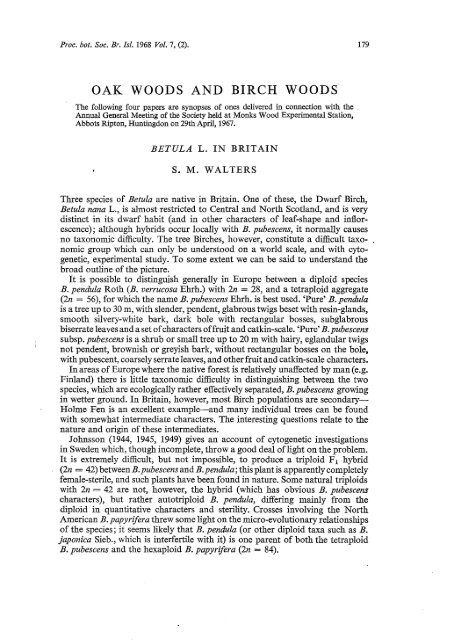pdf 98kb - BSBI Archive
pdf 98kb - BSBI Archive
pdf 98kb - BSBI Archive
Create successful ePaper yourself
Turn your PDF publications into a flip-book with our unique Google optimized e-Paper software.
Proc. bot. Soc. Br. Is!. 1968 Vol. 7, (2).<br />
179<br />
OAK WOODS AND BIRCH WOODS<br />
The following four papers are synopses of ones delivered in connection with the<br />
Annual General Meeting of the Society held at Monks Wood Experimental Station,<br />
Abbots Ripton, Huntmgdon on 29th April, 1967.<br />
BETULA L. IN BRITAIN<br />
S. M. WALTERS<br />
Three species of Betula are native in Britain. One of these, the Dwarf Birch,<br />
Betula nana L., is almost restricted to Central and North Scotland, and is very<br />
distinct in its dwarf habit (and in other characters of leaf-shape and inflorescence);<br />
although hybrids occur locally with B. pubescens, it normally causes<br />
no taxonomic difficulty. The tree Birches, however, constitute a difficult taxonomic<br />
group which can only be understood on a world scale, and with cytogenetic,<br />
experimental study. To some extent we can be said to understand the<br />
broad outline of the picture.<br />
It is possible to distinguish generally in Europe between a diploid species<br />
B. pendula Roth (B. verrucosa Ehrh.) with 2n = 28, and a tetraploid aggregate<br />
(2n = 56), for which the name B. pubescens Ehrh. is best used. 'Pure' B. pendula<br />
is a tree up to 30 m, with slender, pendent, glabrous twigs beset with resin-glands,<br />
smooth silvery-white bark, dark bole with rectangular bosses, subglabrous<br />
biserrate leaves and a set of characters of fruit and catkin-scale. 'Pure' B. pubescens<br />
subsp. pubescens is a shrub or small tree up to 20 m with hairy, eglandular twigs<br />
not pendent, brownish or greyish bark, without rectangular bosses on the bole,<br />
with pubescent, coarsely serrate leaves, and other fruit and catkin-scale characters.<br />
In areas of Europe where the native forest is relatively unaffected by man (e.g.<br />
Finland) there is little taxonomic difficulty in distinguishing between the two<br />
species, which are ecologically rather effectively separated, B. pubescens growing<br />
in wetter ground. In Britain, however, most Birch populations are secondary<br />
Holme Fen is an excellent example-and many individual trees can be found<br />
with somewhat intermediate characters. The interesting questions relate to the<br />
nature and origin of these intermediates.<br />
10hnsson (1944, 1945, 1949) gives an account of cytogenetic investigations<br />
in Sweden which, though incomplete, throw a good deal of light on the problem.<br />
It is extremely difficult, but not impossible, to produce a triploid F 1 hybrid<br />
(2n = 42) between B. pubescens and B. pendula; this plant is apparently completely<br />
female-sterile, and such plants have been found in nature. Some natural triploids<br />
with 2n = 42 are not, however, the hybrid (which has obvious B. pubescens<br />
characters), but rather autotriploid B. pendula, differing mainly from the<br />
diploid in quantitative characters and sterility. Crosses involving the North<br />
American B. papyrifera threw some light on the micro-evolutionary relationships<br />
of the species; it seems likely that B. pendula (or other diploid taxa such as B.<br />
japonica Sieb., which is interfertile with it) is one parent of both the tetraploid<br />
B. pubescens and the hexaploid B. papyrifera (2n = 84).
180 S. M. WALTERS<br />
The interesting question is: what is the other likely diploid parent involved<br />
in B. pubescens, or should we look for more than one to explain some of the<br />
enormous variability in the tetraploid? On purely morphological grounds the<br />
Central and East European shrub B. humilis Schrank is an obvious candidate;<br />
but, so far as I am aware, no genetical work has yet been done involving this<br />
species.<br />
Cytological investigation of apparently hybrid populations in Britain could<br />
throw much light on the nature and extent of introgression from diploid to<br />
tetraploid, and the efficiency of isolating factors such as differing ecological<br />
preference, flowering time, etc. It is possible to get mitotic counts from young<br />
leaves (Skalinska et al1959) so that some progress can be made in determining<br />
whether individual trees are triploid or not. Any 'hybrid-index' analysis of the<br />
field populations (cf Natho 1959) suffers from the severe disadvantage that our<br />
'pure' reference-points are sUbjective ... indeed, if some introgression is possible<br />
and if the tetraploid has a polytopic origin, we may be pursuing a will-o-the-wisp<br />
in looking for 'pure' pubescens at all!<br />
REFERENCES<br />
JOHNSSON, H. (1944). Triploidy in Betula alba L. Bot. notiser, 1944, 85-89.<br />
JOHNSSON, H. (1945). Interspecifichybridization within the genus Betula. Hereditas, 31,163-176.<br />
JOHNSSON, H. (1949). Studies on birch species hybrids. 1. Betula verrucosa x B. japonica,<br />
B. verrucosa x B. papyri/era and B. pubescens x B. papyri/era. Hereditas, 35, 115-135.<br />
NATHO, G. (1959). Variationsbreite und Bastardbildung bei mitteleuropiiischen Birkensippen.<br />
Feddes Repert., 61, 211-273.<br />
SKAliNSKA, M., et. al. (1959). Further studies in chromosome numbers of Polish Angiosperms<br />
(Dicotyledons). Acta Soc. Bot. Pol., 28, 487-488.
















